SKODA OCTAVIA 2014 3.G / (5E) Owner's Manual
Manufacturer: SKODA, Model Year: 2014, Model line: OCTAVIA, Model: SKODA OCTAVIA 2014 3.G / (5E)Pages: 280, PDF Size: 35.53 MB
Page 211 of 280
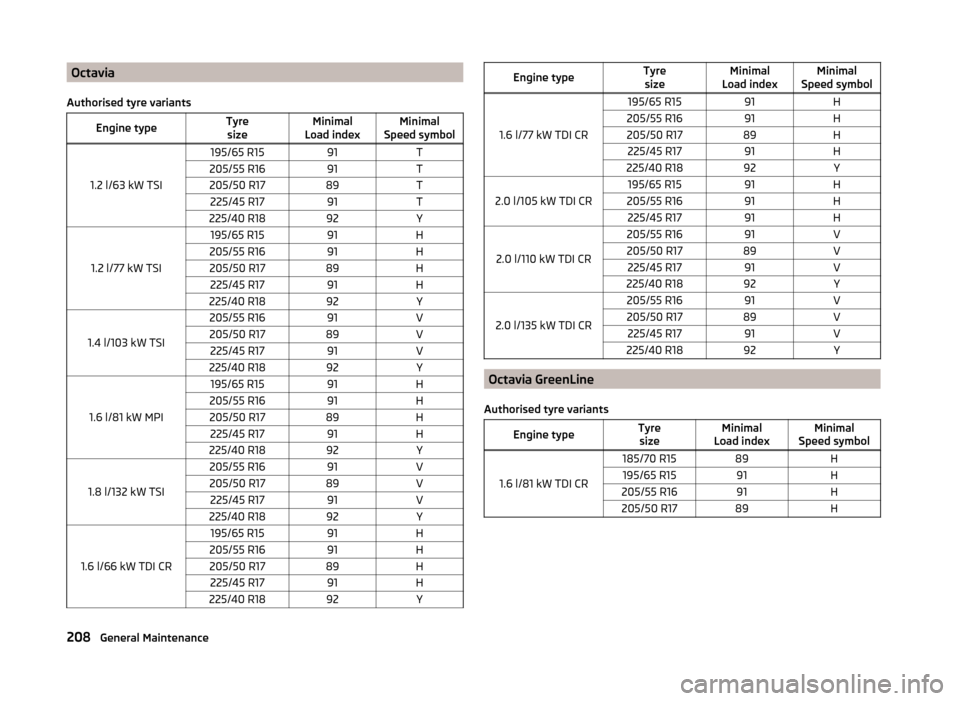
Octavia
Authorised tyre variantsEngine typeTyre sizeMinimal
Load indexMinimal
Speed symbol
1.2 l/63 kW TSI
195/65 R1591T205/55 R1691T205/50 R1789T225/45 R1791T225/40 R1892Y
1.2 l/77 kW TSI
195/65 R1591H205/55 R1691H205/50 R1789H225/45 R1791H225/40 R1892Y
1.4 l/103 kW TSI
205/55 R1691V205/50 R1789V225/45 R1791V225/40 R1892Y
1.6 l/81 kW MPI
195/65 R1591H205/55 R1691H205/50 R1789H225/45 R1791H225/40 R1892Y
1.8 l/132 kW TSI
205/55 R1691V205/50 R1789V225/45 R1791V225/40 R1892Y
1.6 l/66 kW TDI CR
195/65 R1591H205/55 R1691H205/50 R1789H225/45 R1791H225/40 R1892YEngine typeTyre sizeMinimal
Load indexMinimal
Speed symbol
1.6 l/77 kW TDI CR
195/65 R1591H205/55 R1691H205/50 R1789H225/45 R1791H225/40 R1892Y
2.0 l/105 kW TDI CR
195/65 R1591H205/55 R1691H225/45 R1791H
2.0 l/110 kW TDI CR
205/55 R1691V205/50 R1789V225/45 R1791V225/40 R1892Y
2.0 l/135 kW TDI CR
205/55 R1691V205/50 R1789V225/45 R1791V225/40 R1892Y
Octavia GreenLine
Authorised tyre variants
Engine typeTyre sizeMinimal
Load indexMinimal
Speed symbol
1.6 l/81 kW TDI CR
185/70 R1589H195/65 R1591H205/55 R1691H205/50 R1789H208General Maintenance
Page 212 of 280
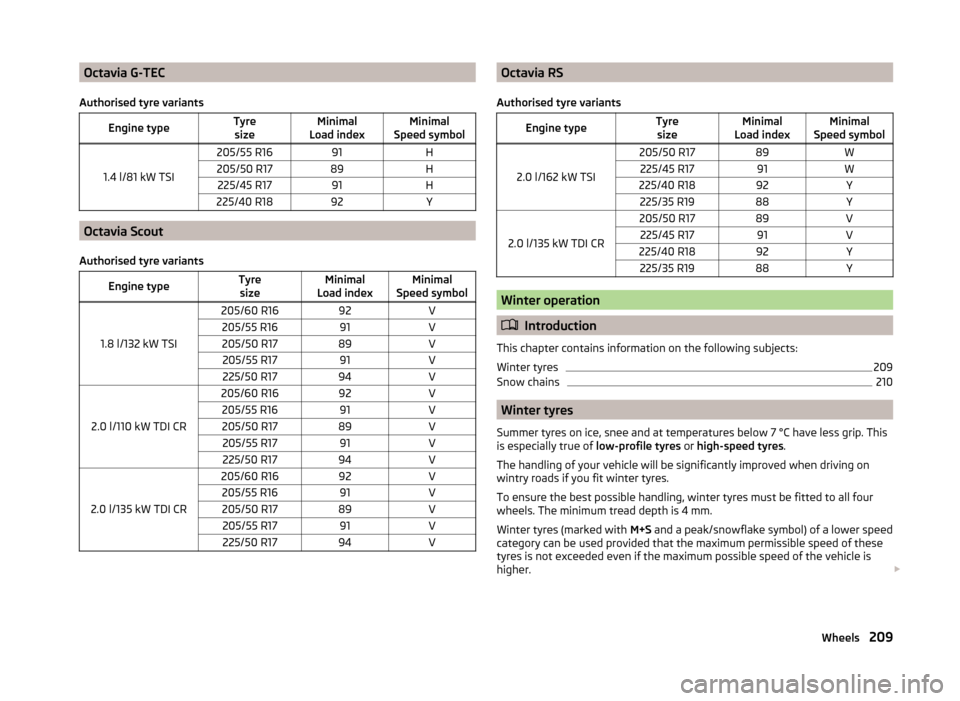
Octavia G-TEC
Authorised tyre variantsEngine typeTyre sizeMinimal
Load indexMinimal
Speed symbol
1.4 l/81 kW TSI
205/55 R1691H205/50 R1789H225/45 R1791H225/40 R1892Y
Octavia Scout
Authorised tyre variants
Engine typeTyre sizeMinimal
Load indexMinimal
Speed symbol
1.8 l/132 kW TSI
205/60 R1692V205/55 R1691V205/50 R1789V205/55 R1791V225/50 R1794V
2.0 l/110 kW TDI CR
205/60 R1692V205/55 R1691V205/50 R1789V205/55 R1791V225/50 R1794V
2.0 l/135 kW TDI CR
205/60 R1692V205/55 R1691V205/50 R1789V205/55 R1791V225/50 R1794VOctavia RS
Authorised tyre variantsEngine typeTyre sizeMinimal
Load indexMinimal
Speed symbol
2.0 l/162 kW TSI
205/50 R1789W225/45 R1791W225/40 R1892Y225/35 R1988Y
2.0 l/135 kW TDI CR
205/50 R1789V225/45 R1791V225/40 R1892Y225/35 R1988Y
Winter operation
Introduction
This chapter contains information on the following subjects:
Winter tyres
209
Snow chains
210
Winter tyres
Summer tyres on ice, snee and at temperatures below 7 °C have less grip. This
is especially true of low-profile tyres or high-speed tyres .
The handling of your vehicle will be significantly improved when driving on
wintry roads if you fit winter tyres.
To ensure the best possible handling, winter tyres must be fitted to all four
wheels. The minimum tread depth is 4 mm.
Winter tyres (marked with M+S and a peak/snowflake symbol) of a lower speed
category can be used provided that the maximum permissible speed of these
tyres is not exceeded even if the maximum possible speed of the vehicle is
higher.
209Wheels
Page 213 of 280
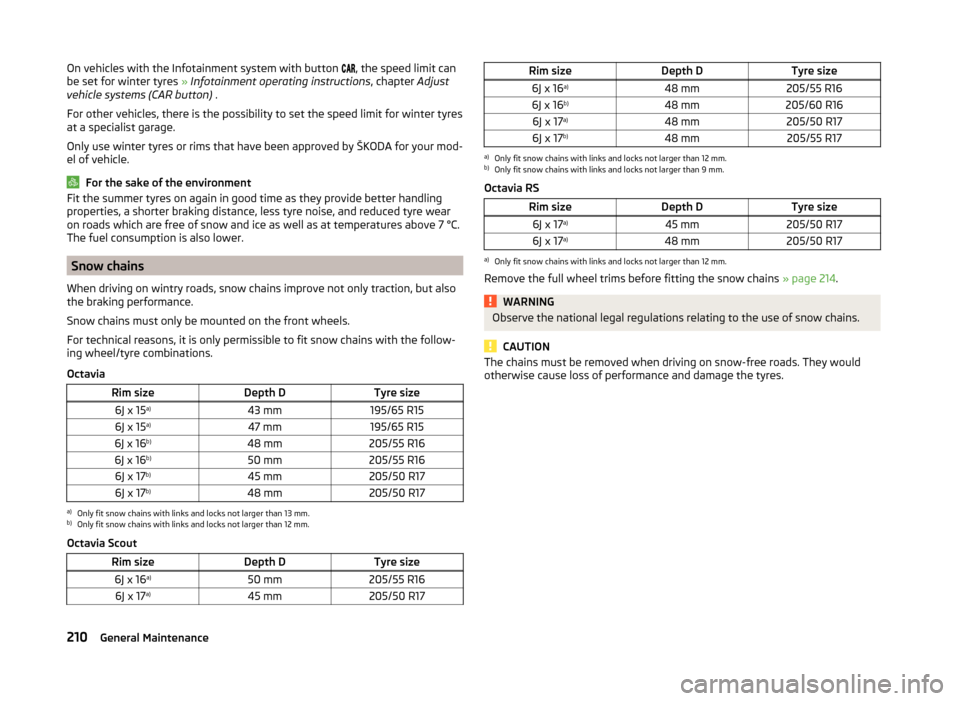
On vehicles with the Infotainment system with button , the speed limit can
be set for winter tyres » Infotainment operating instructions , chapter Adjust
vehicle systems (CAR button) .
For other vehicles, there is the possibility to set the speed limit for winter tyres
at a specialist garage.
Only use winter tyres or rims that have been approved by ŠKODA for your mod- el of vehicle.
For the sake of the environment
Fit the summer tyres on again in good time as they provide better handling
properties, a shorter braking distance, less tyre noise, and reduced tyre wear
on roads which are free of snow and ice as well as at temperatures above 7 °C.
The fuel consumption is also lower.
Snow chains
When driving on wintry roads, snow chains improve not only traction, but also
the braking performance.
Snow chains must only be mounted on the front wheels.
For technical reasons, it is only permissible to fit snow chains with the follow-
ing wheel/tyre combinations.
Octavia
Rim sizeDepth DTyre size6J x 15 a)43 mm195/65 R156J x 15a)47 mm195/65 R156J x 16 b)48 mm205/55 R166J x 16b)50 mm205/55 R166J x 17b)45 mm205/50 R176J x 17 b)48 mm205/50 R17a)
Only fit snow chains with links and locks not larger than 13 mm.
b)
Only fit snow chains with links and locks not larger than 12 mm.
Octavia Scout
Rim sizeDepth DTyre size6J x 16 a)50 mm205/55 R166J x 17a)45 mm205/50 R17Rim sizeDepth DTyre size6J x 16 a)48 mm205/55 R166J x 16b)48 mm205/60 R166J x 17a)48 mm205/50 R176J x 17b)48 mm205/55 R17a)
Only fit snow chains with links and locks not larger than 12 mm.
b)
Only fit snow chains with links and locks not larger than 9 mm.
Octavia RS
Rim sizeDepth DTyre size6J x 17 a)45 mm205/50 R176J x 17 a)48 mm205/50 R17a)
Only fit snow chains with links and locks not larger than 12 mm.
Remove the full wheel trims before fitting the snow chains » page 214.
WARNINGObserve the national legal regulations relating to the use of snow chains.
CAUTION
The chains must be removed when driving on snow-free roads. They would
otherwise cause loss of performance and damage the tyres.210General Maintenance
Page 214 of 280
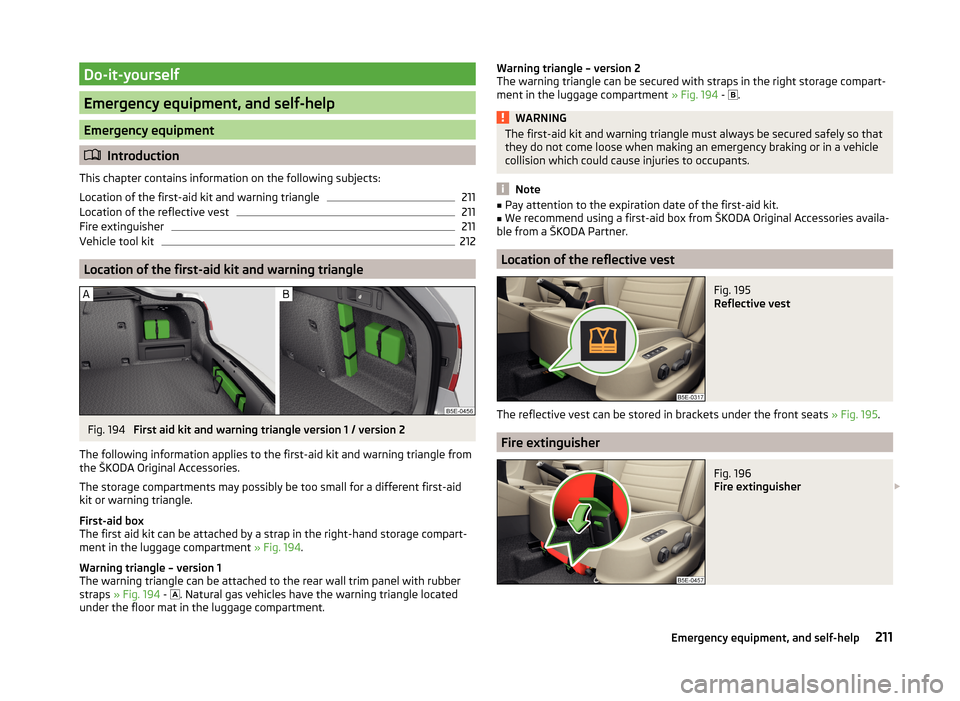
Do-it-yourself
Emergency equipment, and self-help
Emergency equipment
Introduction
This chapter contains information on the following subjects:
Location of the first-aid kit and warning triangle
211
Location of the reflective vest
211
Fire extinguisher
211
Vehicle tool kit
212
Location of the first-aid kit and warning triangle
Fig. 194
First aid kit and warning triangle version 1 / version 2
The following information applies to the first-aid kit and warning triangle from the ŠKODA Original Accessories.
The storage compartments may possibly be too small for a different first-aid
kit or warning triangle.
First-aid box
The first aid kit can be attached by a strap in the right-hand storage compart-
ment in the luggage compartment » Fig. 194.
Warning triangle – version 1
The warning triangle can be attached to the rear wall trim panel with rubber
straps » Fig. 194 -
. Natural gas vehicles have the warning triangle located
under the floor mat in the luggage compartment.
Warning triangle – version 2
The warning triangle can be secured with straps in the right storage compart-
ment in the luggage compartment » Fig. 194 -
.WARNINGThe first-aid kit and warning triangle must always be secured safely so that
they do not come loose when making an emergency braking or in a vehicle
collision which could cause injuries to occupants.
Note
■ Pay attention to the expiration date of the first-aid kit.■We recommend using a first-aid box from ŠKODA Original Accessories availa-
ble from a ŠKODA Partner.
Location of the reflective vest
Fig. 195
Reflective vest
The reflective vest can be stored in brackets under the front seats » Fig. 195.
Fire extinguisher
Fig. 196
Fire extinguisher
211Emergency equipment, and self-help
Page 215 of 280
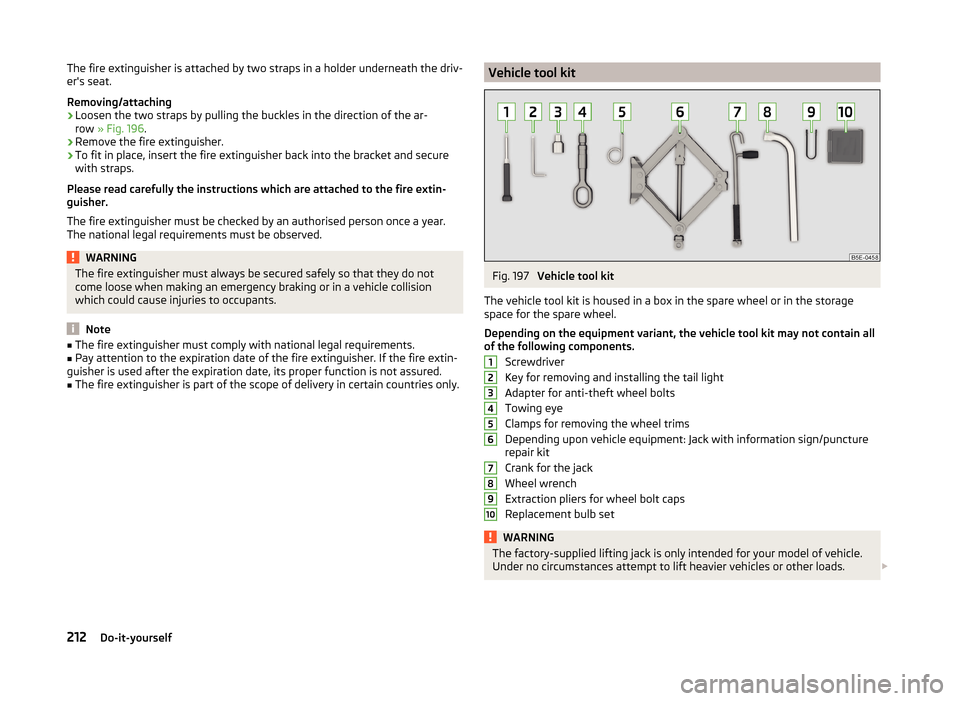
The fire extinguisher is attached by two straps in a holder underneath the driv-
er's seat.
Removing/attaching›
Loosen the two straps by pulling the buckles in the direction of the ar-
row » Fig. 196 .
›
Remove the fire extinguisher.
›
To fit in place, insert the fire extinguisher back into the bracket and secure
with straps.
Please read carefully the instructions which are attached to the fire extin- guisher.
The fire extinguisher must be checked by an authorised person once a year.
The national legal requirements must be observed.
WARNINGThe fire extinguisher must always be secured safely so that they do not
come loose when making an emergency braking or in a vehicle collision
which could cause injuries to occupants.
Note
■ The fire extinguisher must comply with national legal requirements.■Pay attention to the expiration date of the fire extinguisher. If the fire extin-
guisher is used after the expiration date, its proper function is not assured.■
The fire extinguisher is part of the scope of delivery in certain countries only.
Vehicle tool kitFig. 197
Vehicle tool kit
The vehicle tool kit is housed in a box in the spare wheel or in the storage
space for the spare wheel.
Depending on the equipment variant, the vehicle tool kit may not contain all
of the following components.
Screwdriver
Key for removing and installing the tail light
Adapter for anti-theft wheel bolts
Towing eye
Clamps for removing the wheel trims
Depending upon vehicle equipment: Jack with information sign/puncture
repair kit
Crank for the jack
Wheel wrench
Extraction pliers for wheel bolt caps
Replacement bulb set
WARNINGThe factory-supplied lifting jack is only intended for your model of vehicle.
Under no circumstances attempt to lift heavier vehicles or other loads. 12345678910212Do-it-yourself
Page 216 of 280

CAUTION■Screw the jack back into the starting position before storing in the box with
the vehicle tool kit.■
Ensure that the vehicle tool kit is safely secured in the luggage compart-
ment.
■
Ensure that the box is always secured with the strap.
Note
The declaration of conformity is included with the jack or the log folder.
Reserve and temporary spare
Introduction
This chapter contains information on the following subjects:
Removing/storing the wheel
213
Spare wheel
213
When using an emergency or spare wheel make sure to fit a wheel with the
appropriate dimensions and design as soon as possible.
After changing the spare wheel, the tyre pressure must be adjusted. In vehi-
cles with tyre pressure monitoring, tyre pressure values must be
saved » page 167 .
WARNING■
If the spare tyre with a non-specific or opposite direction of rotation has
to be fitted in the event of a puncture, then drive carefully. The tyre no lon-
ger retains its optimal characteristics in this situation.■
If the dimensions or design of the spare wheel differ from the tyres fitted
to the vehicle (e.g. winter tyres or low-profile tyres), it must only be used
briefly in the event of a puncture and if an appropriately cautious style of
driving is adopted.
■
If the dimensions or design of the temporary spare wheel differ from the
fitted tyres, never drive faster than 80 km/h (or 50 mph).
■
Never use the temporary spare wheel if it is damaged.
Removing/storing the wheelFig. 198
Removing the wheel
Read and observe on page 213 first.
The wheel is located in a well under the floor covering in the boot and is fixed in place with special bolt
B
» Fig. 198 .
Take out wheel
›
Open the boot lid.
›
Raise the floor covering in the boot » page 106.
›
Remove the box with the tool kit.
›
Remove locking
A
in the direction of arrow
1
» Fig. 198 .
›
Unscrew nut
B
in the direction of arrow
2
.
›
Remove the wheel.
Store wheel away
›
Place the wheel into the spare wheel well with the wheel rim pointing down-
ward.
›
Screw in nut
B
in the opposite direction to arrow
2
» Fig. 198 .
›
Insert locking
A
in the opposite direction to which arrow
1
is pointing.
›
Place the box with the tool kit back into the spare wheel and secure it with
the tape.
›
Fold back the floor covering in the boot » page 110.
›
Shut the boot lid.
Spare wheel
Read and observe
on page 213 first.
A yellow warning label is displayed on the rim of the temporary spare wheel.
213Emergency equipment, and self-help
Page 217 of 280
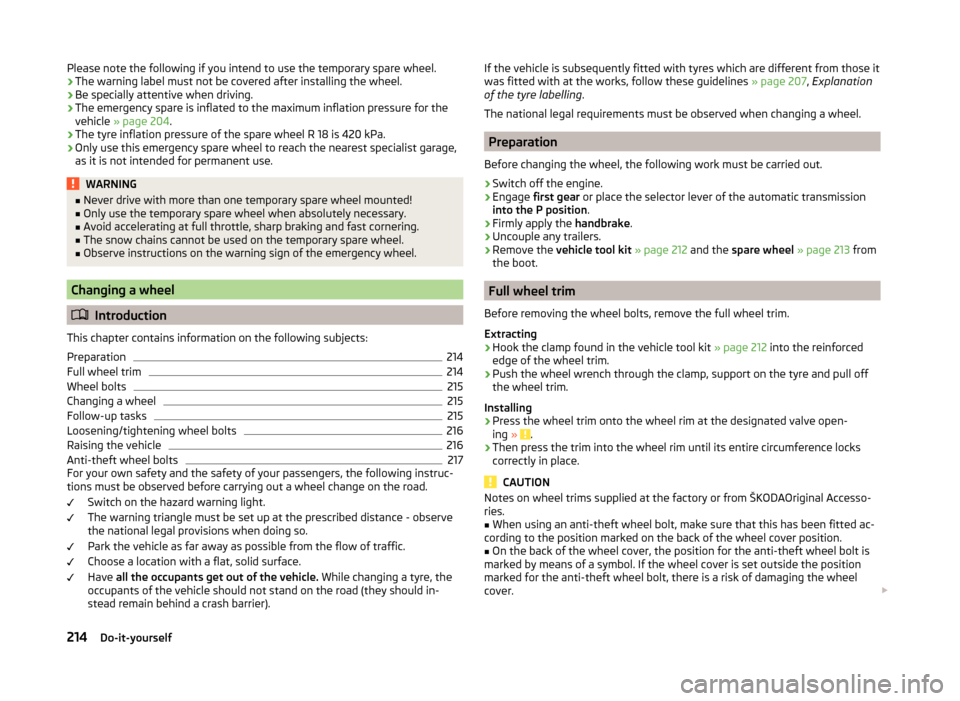
Please note the following if you intend to use the temporary spare wheel.› The warning label must not be covered after installing the wheel.
› Be specially attentive when driving.
› The emergency spare is inflated to the maximum inflation pressure for the
vehicle » page 204 .
› The tyre inflation pressure of the spare wheel R 18 is 420 kPa.
› Only use this emergency spare wheel to reach the nearest specialist garage,
as it is not intended for permanent use.WARNING■ Never drive with more than one temporary spare wheel mounted!■Only use the temporary spare wheel when absolutely necessary.■
Avoid accelerating at full throttle, sharp braking and fast cornering.
■
The snow chains cannot be used on the temporary spare wheel.
■
Observe instructions on the warning sign of the emergency wheel.
Changing a wheel
Introduction
This chapter contains information on the following subjects:
Preparation
214
Full wheel trim
214
Wheel bolts
215
Changing a wheel
215
Follow-up tasks
215
Loosening/tightening wheel bolts
216
Raising the vehicle
216
Anti-theft wheel bolts
217
For your own safety and the safety of your passengers, the following instruc-
tions must be observed before carrying out a wheel change on the road.
Switch on the hazard warning light.
The warning triangle must be set up at the prescribed distance - observe
the national legal provisions when doing so.
Park the vehicle as far away as possible from the flow of traffic.
Choose a location with a flat, solid surface.
Have all the occupants get out of the vehicle. While changing a tyre, the
occupants of the vehicle should not stand on the road (they should in-
stead remain behind a crash barrier).
If the vehicle is subsequently fitted with tyres which are different from those it
was fitted with at the works, follow these guidelines » page 207, Explanation
of the tyre labelling .
The national legal requirements must be observed when changing a wheel.
Preparation
Before changing the wheel, the following work must be carried out.
›
Switch off the engine.
›
Engage first gear or place the selector lever of the automatic transmission
into the P position .
›
Firmly apply the handbrake.
›
Uncouple any trailers.
›
Remove the vehicle tool kit » page 212 and the spare wheel » page 213 from
the boot.
Full wheel trim
Before removing the wheel bolts, remove the full wheel trim.
Extracting
›
Hook the clamp found in the vehicle tool kit » page 212 into the reinforced
edge of the wheel trim.
›
Push the wheel wrench through the clamp, support on the tyre and pull off
the wheel trim.
Installing
›
Press the wheel trim onto the wheel rim at the designated valve open-
ing » .
›
Then press the trim into the wheel rim until its entire circumference locks
correctly in place.
CAUTION
Notes on wheel trims supplied at the factory or from ŠKODAOriginal Accesso-
ries.■
When using an anti-theft wheel bolt, make sure that this has been fitted ac-
cording to the position marked on the back of the wheel cover position.
■
On the back of the wheel cover, the position for the anti-theft wheel bolt is
marked by means of a symbol. If the wheel cover is set outside the position
marked for the anti-theft wheel bolt, there is a risk of damaging the wheel
cover.
214Do-it-yourself
Page 218 of 280
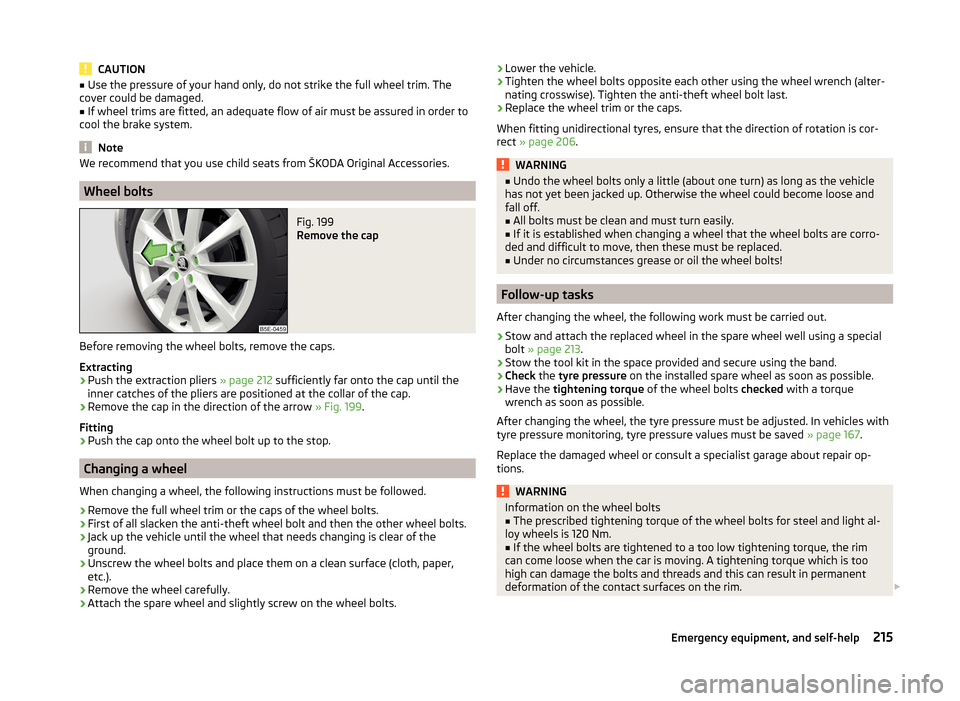
CAUTION■Use the pressure of your hand only, do not strike the full wheel trim. The
cover could be damaged.■
If wheel trims are fitted, an adequate flow of air must be assured in order to
cool the brake system.
Note
We recommend that you use child seats from ŠKODA Original Accessories.
Wheel bolts
Fig. 199
Remove the cap
Before removing the wheel bolts, remove the caps.
Extracting
›
Push the extraction pliers » page 212 sufficiently far onto the cap until the
inner catches of the pliers are positioned at the collar of the cap.
›
Remove the cap in the direction of the arrow » Fig. 199.
Fitting
›
Push the cap onto the wheel bolt up to the stop.
Changing a wheel
When changing a wheel, the following instructions must be followed.
›
Remove the full wheel trim or the caps of the wheel bolts.
›
First of all slacken the anti-theft wheel bolt and then the other wheel bolts.
›
Jack up the vehicle until the wheel that needs changing is clear of the
ground.
›
Unscrew the wheel bolts and place them on a clean surface (cloth, paper, etc.).
›
Remove the wheel carefully.
›
Attach the spare wheel and slightly screw on the wheel bolts.
› Lower the vehicle.›Tighten the wheel bolts opposite each other using the wheel wrench (alter-
nating crosswise). Tighten the anti-theft wheel bolt last.›
Replace the wheel trim or the caps.
When fitting unidirectional tyres, ensure that the direction of rotation is cor-
rect » page 206 .
WARNING■
Undo the wheel bolts only a little (about one turn) as long as the vehicle
has not yet been jacked up. Otherwise the wheel could become loose and
fall off.■
All bolts must be clean and must turn easily.
■
If it is established when changing a wheel that the wheel bolts are corro-
ded and difficult to move, then these must be replaced.
■
Under no circumstances grease or oil the wheel bolts!
Follow-up tasks
After changing the wheel, the following work must be carried out.
›
Stow and attach the replaced wheel in the spare wheel well using a special
bolt » page 213 .
›
Stow the tool kit in the space provided and secure using the band.
›
Check the tyre pressure on the installed spare wheel as soon as possible.
›
Have the tightening torque of the wheel bolts checked with a torque
wrench as soon as possible.
After changing the wheel, the tyre pressure must be adjusted. In vehicles with
tyre pressure monitoring, tyre pressure values must be saved » page 167.
Replace the damaged wheel or consult a specialist garage about repair op-
tions.
WARNINGInformation on the wheel bolts■The prescribed tightening torque of the wheel bolts for steel and light al-
loy wheels is 120 Nm.■
If the wheel bolts are tightened to a too low tightening torque, the rim
can come loose when the car is moving. A tightening torque which is too
high can damage the bolts and threads and this can result in permanent
deformation of the contact surfaces on the rim.
215Emergency equipment, and self-help
Page 219 of 280
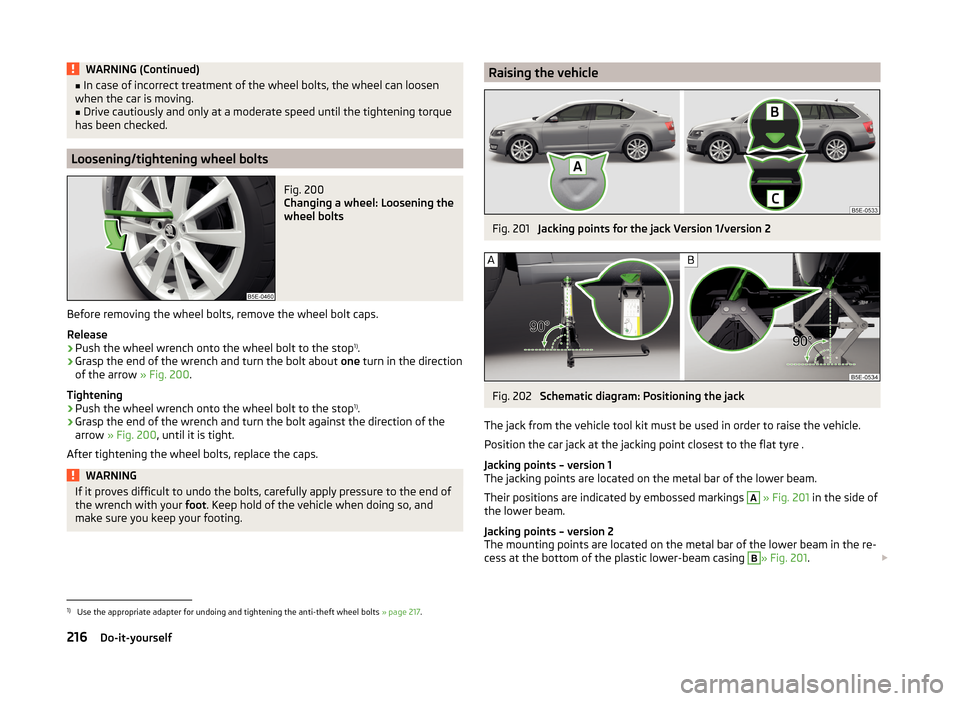
WARNING (Continued)■In case of incorrect treatment of the wheel bolts, the wheel can loosen
when the car is moving.■
Drive cautiously and only at a moderate speed until the tightening torque
has been checked.
Loosening/tightening wheel bolts
Fig. 200
Changing a wheel: Loosening the
wheel bolts
Before removing the wheel bolts, remove the wheel bolt caps.
Release
›
Push the wheel wrench onto the wheel bolt to the stop 1)
.
›
Grasp the end of the wrench and turn the bolt about one turn in the direction
of the arrow » Fig. 200.
Tightening
›
Push the wheel wrench onto the wheel bolt to the stop 1)
.
›
Grasp the end of the wrench and turn the bolt against the direction of the
arrow » Fig. 200 , until it is tight.
After tightening the wheel bolts, replace the caps.
WARNINGIf it proves difficult to undo the bolts, carefully apply pressure to the end of
the wrench with your foot. Keep hold of the vehicle when doing so, and
make sure you keep your footing.Raising the vehicleFig. 201
Jacking points for the jack Version 1/version 2
Fig. 202
Schematic diagram: Positioning the jack
The jack from the vehicle tool kit must be used in order to raise the vehicle.
Position the car jack at the jacking point closest to the flat tyre .
Jacking points – version 1
The jacking points are located on the metal bar of the lower beam.
Their positions are indicated by embossed markings
A
» Fig. 201 in the side of
the lower beam.
Jacking points – version 2
The mounting points are located on the metal bar of the lower beam in the re-
cess at the bottom of the plastic lower-beam casing
B
» Fig. 201 .
1)
Use the appropriate adapter for undoing and tightening the anti-theft wheel bolts
» page 217.
216Do-it-yourself
Page 220 of 280
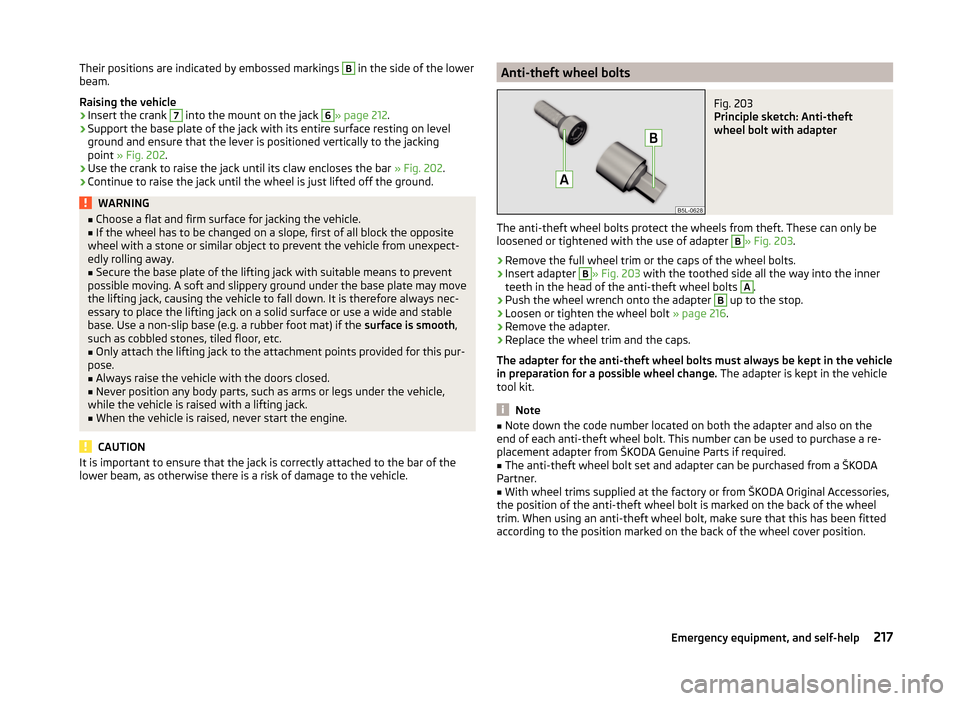
Their positions are indicated by embossed markings B in the side of the lower
beam.
Raising the vehicle›
Insert the crank
7
into the mount on the jack
6
» page 212 .
›
Support the base plate of the jack with its entire surface resting on level
ground and ensure that the lever is positioned vertically to the jacking
point » Fig. 202 .
›
Use the crank to raise the jack until its claw encloses the bar » Fig. 202.
›
Continue to raise the jack until the wheel is just lifted off the ground.
WARNING■
Choose a flat and firm surface for jacking the vehicle.■If the wheel has to be changed on a slope, first of all block the opposite
wheel with a stone or similar object to prevent the vehicle from unexpect-
edly rolling away.■
Secure the base plate of the lifting jack with suitable means to prevent
possible moving. A soft and slippery ground under the base plate may move
the lifting jack, causing the vehicle to fall down. It is therefore always nec-
essary to place the lifting jack on a solid surface or use a wide and stable
base. Use a non-slip base (e.g. a rubber foot mat) if the surface is smooth,
such as cobbled stones, tiled floor, etc.
■
Only attach the lifting jack to the attachment points provided for this pur-
pose.
■
Always raise the vehicle with the doors closed.
■
Never position any body parts, such as arms or legs under the vehicle,
while the vehicle is raised with a lifting jack.
■
When the vehicle is raised, never start the engine.
CAUTION
It is important to ensure that the jack is correctly attached to the bar of the
lower beam, as otherwise there is a risk of damage to the vehicle.Anti-theft wheel boltsFig. 203
Principle sketch: Anti-theft
wheel bolt with adapter
The anti-theft wheel bolts protect the wheels from theft. These can only be
loosened or tightened with the use of adapter
B
» Fig. 203 .
›
Remove the full wheel trim or the caps of the wheel bolts.
›
Insert adapter
B
» Fig. 203 with the toothed side all the way into the inner
teeth in the head of the anti-theft wheel bolts
A
.
›
Push the wheel wrench onto the adapter
B
up to the stop.
›
Loosen or tighten the wheel bolt » page 216.
›
Remove the adapter.
›
Replace the wheel trim and the caps.
The adapter for the anti-theft wheel bolts must always be kept in the vehicle
in preparation for a possible wheel change. The adapter is kept in the vehicle
tool kit.
Note
■ Note down the code number located on both the adapter and also on the
end of each anti-theft wheel bolt. This number can be used to purchase a re-
placement adapter from ŠKODA Genuine Parts if required.■
The anti-theft wheel bolt set and adapter can be purchased from a ŠKODA
Partner.
■
With wheel trims supplied at the factory or from ŠKODA Original Accessories,
the position of the anti-theft wheel bolt is marked on the back of the wheel
trim. When using an anti-theft wheel bolt, make sure that this has been fitted
according to the position marked on the back of the wheel cover position.
217Emergency equipment, and self-help